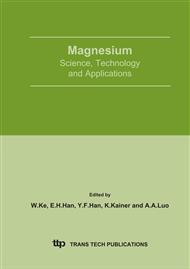p.147
p.151
p.155
p.161
p.165
p.169
p.177
p.181
p.185
The Effect of Mould Constraints on the 0.2% Proof Stress of As-Cast Mg-Al Alloys
Abstract:
When a casting solidifies and cools down in a metallic mould, stresses and strains develop as a result of uneven temperature distributions, metal shrinkage and mould constraints. At ejection from the mould, the casting usually springs back slightly when the elastic part of the strain is released. However, due to the low flow stress at high temperatures it is likely that the casting also has experienced some plastic deformations, meaning that the dislocation density has increased. This paper discusses how the existence of remaining plastic deformations affects the initial flow behavior and the yield strength during tensile testing of as cast Mg-Al alloys with different degrees of mould constraints.
Info:
Periodical:
Pages:
165-168
Citation:
Online since:
July 2005
Authors:
Price:
Сopyright:
© 2005 Trans Tech Publications Ltd. All Rights Reserved
Share:
Citation:


